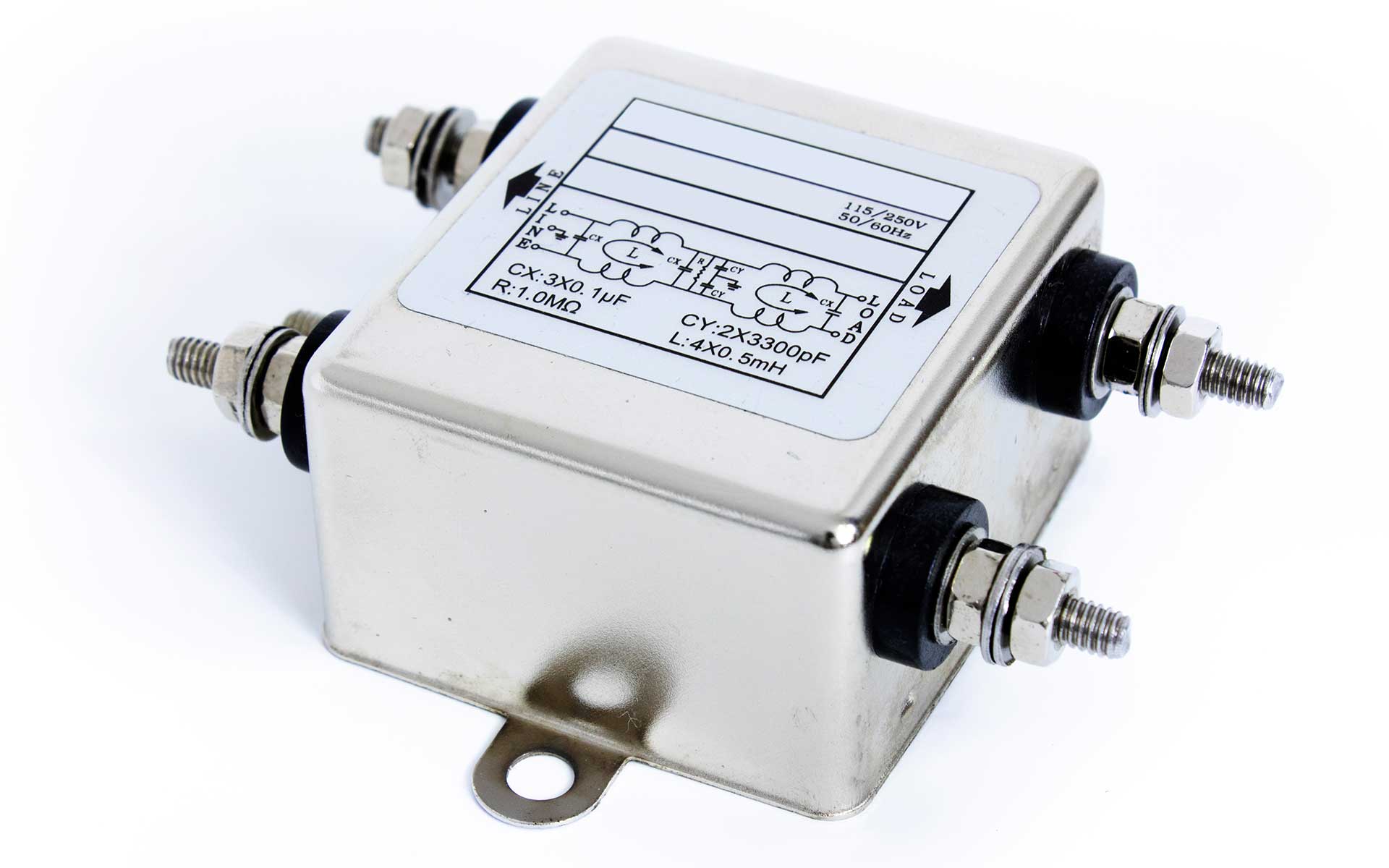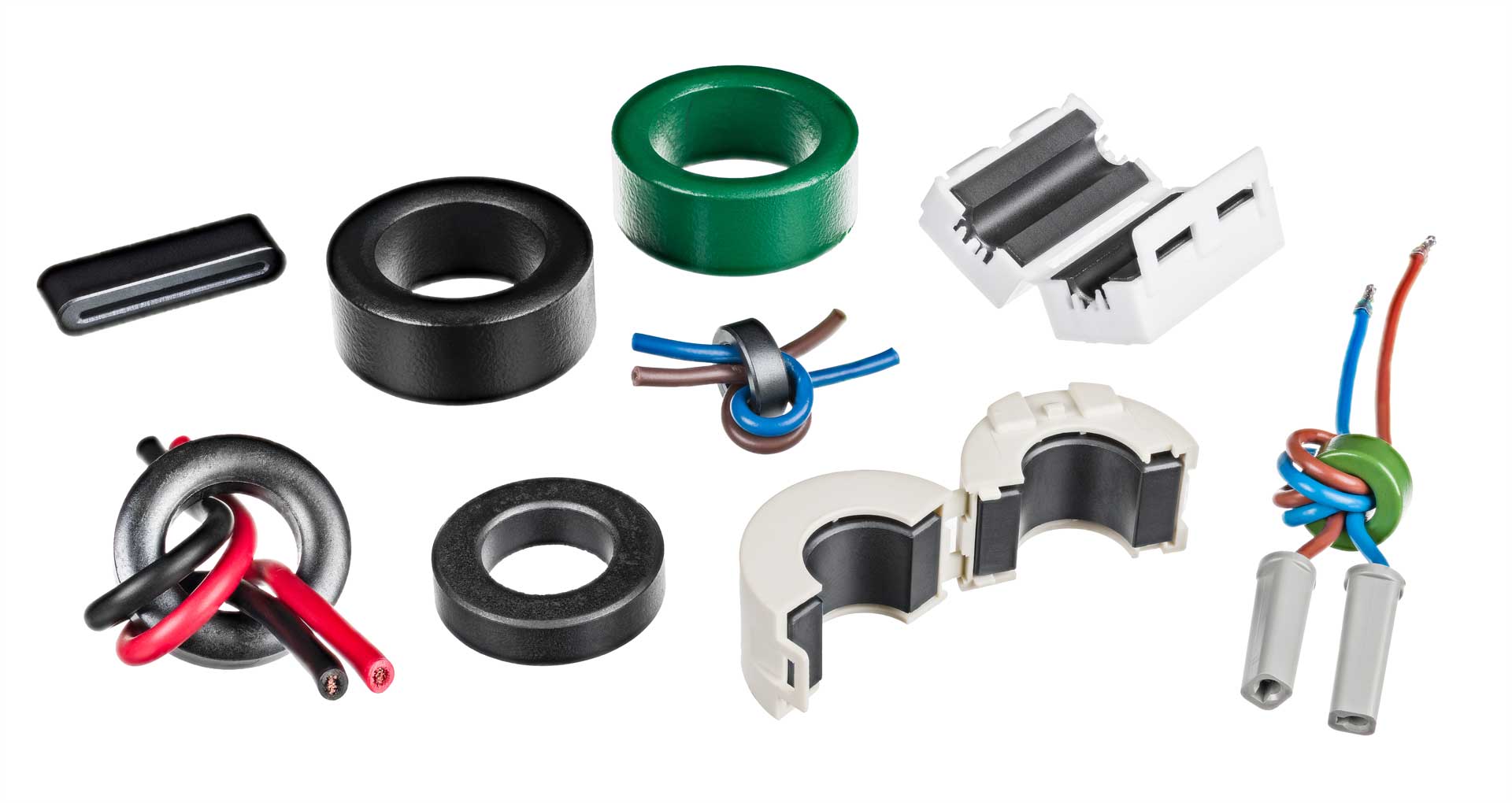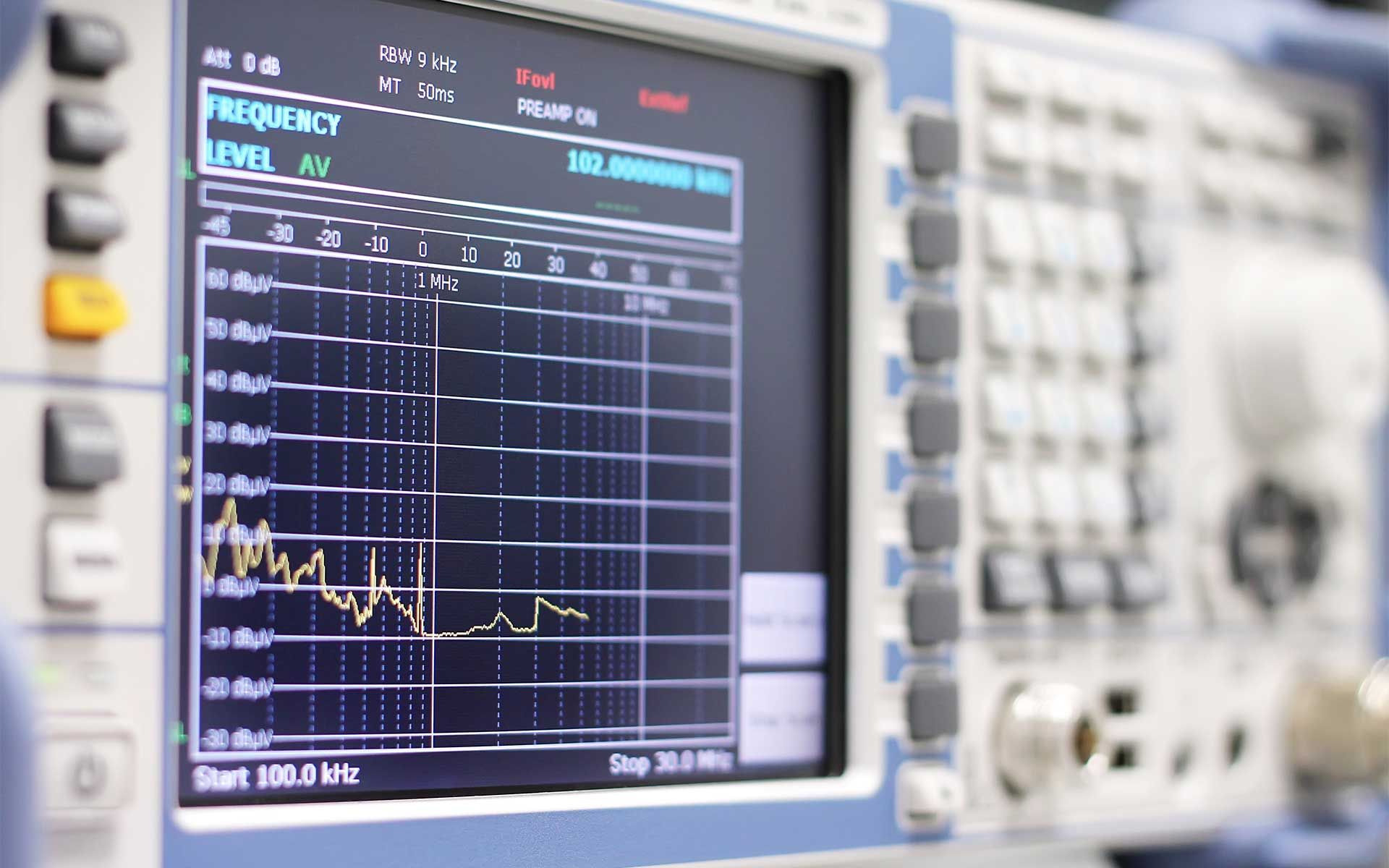If you have ever wondered why cell phones must be turned off or switched to airplane mode while flying on airplanes, then let’s discuss one of the reasons: electromagnetic interference.
This phenomenon is the disruption or degradation of the performance of electronic devices, equipment, or systems caused by electromagnetic radiation or electromagnetic fields. In other words, modern gadgets and devices, like cell phones, use fast-switching systems that send out strong electrical signals, kind of like tiny electrical waves, both through wires and through the air. These waves can mess with other electronics and cause problems, and we call this electromagnetic interference, or EMI for short.
For this reason, EMI control is a critical aspect of electronic engineering and design in various industries to ensure that technology operates smoothly and without disruptions. Enter EMI Filters, the topic of today’s blog post. EMI filters, or EMI suppression filters, are like gatekeepers for electronic devices.
Types of EMI Filters
EMI filters are like gatekeepers for electronic devices, and we’ll provide more details on how EMI filters work in the next section. However, for now, imagine your electronic device is like a radio trying to tune in to a specific station, but there's a lot of static noise around. EMI filters act like filters on that radio, helping to block out the static so the station can be heard clearly.
Let’s review three distinct EMI filter types: passive, active, and hybrid, including characteristics and applications for each.
Passive EMI Filters
Passive EMI filters rely on passive electronic components, such as resistors, capacitors, and inductors, to filter out unwanted EMI noise. They are generally simple and cost-effective, do not require an external power source or amplification, and are suitable for filtering out high-frequency noise and EMI in a wide range of applications.
Passive filters are commonly used when the interference is limited to a specific frequency range and does not require signal amplification, i.e., power supplies, audio equipment, and other electronic circuits.
Active EMI Filters
Active EMI filters employ active components, such as operational amplifiers (op-amps), to filter and amplify electronic signals. They actively process the input signal to achieve the desired output. Active EMI filters can provide both filtering and signal amplification, making them versatile for a wide range of applications, and they can be designed with variable parameters, allowing for adaptability in different scenarios. Also, active EMI filters require a power supply for operation and may be more complex than passive filters.
Therefore, active EMI filters are necessary when signal amplification and complex filtering are required, such as with audio processing, equalization, and high-frequency communication systems.
Hybrid EMI Filters
Hybrid EMI filters combine the advantages of both passive and active filter technologies to provide filtering and signal conditioning in one package. Hybrid filters can be customized to meet specific EMI filtering and signal conditioning requirements, and they often include operational amplifiers (op-amps) to provide both filtering and amplification.
Hybrid filters are employed in scenarios where EMI filtering and signal amplification must be combined. For example, they are commonly used in instrumentation, precision measurement, and industrial control systems.
How EMI Filters Work
EMI filters are designed to help control and reduce the "noise" created by electrical currents that can interfere with a device's performance or cause issues in nearby devices. For example, when placed at the power entry point to equipment, these filters prevent line noise from entering the equipment.
The science behind the EMI filtering process involves understanding the frequency and amplitude characteristics of unwanted interference and designing circuits that employ components to attenuate or eliminate those unwanted signals selectively. Therefore, the choice of EMI filter components and their configuration depends on the specific EMI challenges and the desired filtering characteristics.
Following are the various EMI filter components involved in the filtering process, including an explanation of each.
Passive Components
- Inductors (L) resist changes in the flow of electrical current and can be used to block high-frequency noise by creating impedance to these signals.
- Capacitors (C) store electrical charge and can be used to bypass high-frequency noise to ground or provide a path for certain frequencies while blocking others.
- Resistors (R) may be employed in specific cases to dampen high-frequency signals; however, they are not typically used in EMI filtering.
- Ferrite Cores can be placed around conductors to absorb and attenuate high-frequency interference.
Active Components
- Operational Amplifiers (Op-Amps) can be used in active EMI filters to amplify signals, implement adjustable filtering characteristics, and provide additional control over the filtering process.
- Transistors, particularly field-effect transistors (FETs) and bipolar junction transistors (BJTs), can be employed to actively control the flow of signals and tailor the filtering response.


Applications of EMI Filters
As technology advances, electronic content follows. EMI has many human-generated sources like cell phone signals, radio signals, and even transportation systems - on top of already existing natural effects like static electricity, lightning storms, and solar flares. EMI filters address and solve EMI challenges in many sectors, including consumer electronics, industrial applications, and communication systems, to improve product performance, ensure compliance with regulatory standards, and enhance the user experience.
EMI Filters in Consumer Electronics
EMI filters in electronics play a crucial role in maintaining product reliability, complying with EMI standards, and improving the overall user experience by reducing interference and ensuring the proper functioning of the devices. Typical applications of EMI filters in electronics you likely encounter daily include computers, laptops, smartphones, household appliances, gaming devices/controllers, and LED lighting.
EMI Filters in Industrial Applications
EMI filters are also critical to the proper functioning, safety, and regulatory compliance of electronic equipment used in industrial applications. Examples of industrial EMI solutions include automation and control systems, variable frequency drives, medical equipment manufacturing, aerospace and defense applications, railway and transportation systems, and oil and gas exploration.
EMI Filters in Communication Systems
When it comes to communications systems, EMI filters are critical to ensuring signal quality, minimizing interference, and maintaining reliable communication. Communication system EMI filters are virtually everywhere, including cell phones and other wireless devices, avionics and aerospace communication systems, power supplies, data cables, cellular network infrastructure, and broadcasting equipment.
Selecting the Right EMI Filter
Choosing EMI filters involves several considerations to ensure effective EMI mitigation and optimal performance. Following are several key filter considerations and information you should gather before EMI filter selection to ensure it aligns with the specific application.
- EMI Source and Type: Identify the source of the electromagnetic interference in your system. Is it primarily internal (e.g., from switching power supplies) or external (e.g., radio transmitters)? Determine whether the interference is common mode, differential mode, or mixed mode.
- Frequency Range: Determine the frequency range of the interference. EMI Filters are designed to attenuate specific frequency bands, so knowing the range is crucial to filter considerations.
- Performance Requirements: Define the level of EMI reduction required. Specify the attenuation (in dB) needed at various frequencies to meet regulatory requirements and ensure proper system operation.
- Impedance Matching: Assess the impedance of the source, load, and transmission lines in your application. Proper impedance matching between the filter and the connected components is essential for effective EMI suppression.
- Voltage and Current Ratings: Select an EMI filter with voltage and current ratings that match or exceed the requirements of your application. Ensure the filter can handle the power levels involved without saturation or failure.
- Regulatory Compliance: Verify the regulatory standards and certifications for your industry and geographic location. Double check the EMI filter selection complies with standards such as FCC (Federal Communications Commission) for radiated emissions or CE (Conformité Européenne) for the European market.
- Environmental Conditions: Consider the operating environment, including temperature, humidity, and exposure to contaminants like dust, chemicals, or moisture, to ensure you are choosing EMI filters that can withstand these conditions without degradation.
- Size and Form Factor: Evaluate the available space for the filter in your system. Filters come in various sizes and form factors, so filter considerations should fit within the layout or enclosure.
- Termination and Connection Types: Ensure that the filter's terminal and connection options are compatible with the connectors and cabling used in your application for easy integration.
- Budget Constraints: Assess the cost when choosing EMI filters to ensure alignment with your project's budget. Balance cost considerations with the filter's performance and regulatory requirements.
- Custom Solutions: For unique or specialized applications, consider custom EMI filter solutions designed to meet specific requirements. Custom filters may offer a better fit for non-standard situations.
- Testing and Validation: Plan to test and validate your EMI filter selection within the specific application to ensure it effectively reduces EMI as required. Real-world testing can confirm that the filter meets performance criteria.
- Long-Term Reliability: Consider the expected service life and reliability requirements of your application, and choose filters from reputable manufacturers known for producing reliable components. Shop high-quality EMI filters conveniently online.
- Installation Ease: Ensure the filter easily integrates into your system for straightforward installation. Compatibility with existing connectors and wiring is essential to simplify the installation process.
Installation of EMI Filters


When it comes to Installing EMI filters, the process will vary depending on the specific application and the type of filter used. However, here is a general step-by-step EMI filter installation guide that complies with typical scenarios. Also, it's important to follow the manufacturer's installation instructions and guidelines provided with the filter. Following the steps outlined, we will also include some common installation mistakes to avoid.
-
Step 1: Safety Precautions
Before installing EMI filters, ensure that the power to the equipment or circuit where you plan to install the EMI filter is turned off to prevent electrical hazards. -
Step 2: Identify Interference Source
Identify the source of electromagnetic interference that you intend to mitigate. Determine whether it's common mode, differential mode, or mixed mode. -
Step 3: Choose the Right Filter
Refer to the earlier section detailing EMI filter selection to ensure success. -
Step 4: Gather Necessary Tools and Materials
Gather the tools and materials required for the installation, including the selected EMI filter, wire strippers, connectors, and any other necessary hardware. -
Step 5: Circuit Disconnection
If the installation involves connecting the filter to an existing circuit, disconnect the power source to the equipment or circuit. -
Step 6: Mounting the EMI Filter
Depending on your application, mount the EMI filter in a suitable location. The filter may be installed directly on the circuit board, within an enclosure, or along a cable or transmission line, depending on your specific requirements. -
Step 7: Wiring Connections
Connect the input and output terminals of the EMI filter to the appropriate wires or cables in your circuit. Ensure that the connections are secure and correctly oriented. Pay attention to polarity and impedance matching if applicable. -
Step 8: Grounding (if required)
Some EMI filters may require grounding for optimal performance. Connect the grounding terminal to a suitable ground point in your system and be sure to follow safety and grounding guidelines. -
Step 9: Reconnect Power
After all connections are secure, you can reconnect the power source to your equipment or circuit. -
Step 10: Testing and Validation
Power on your equipment and monitor its performance. Test for any improvements in EMI suppression and ensure that your equipment operates as expected. -
Step 11: Compliance Check
If your EMI filter installation is for regulatory compliance, ensure that the EMI filter meets the required standards and that your system complies with the relevant regulations. -
Step 12: Documentation
Keep a record of the installation, including any testing results and documentation related to the EMI filter's specifications and compliance.
Following are some common installation mistakes to avoid when installing EMI filters to ensure their effectiveness and safety.
- Incorrect filter selection
- Improper grounding
- Reversed polarity
- Inadequate securement
- Mismatched impedance
- Inadequate testing
- Overlooking regulatory compliance
- Neglecting to document
- Improper cable routing
- Ignoring regular maintenance
- Assuming filters are a universal solution, i.e. one-size-fits-all
Case Studies: EMI Filters in Action
EMI filters surround us in everyday applications and are critical to the functioning of equipment and systems across industries. To demonstrate their effectiveness and necessity, we’ll share an in-depth EMI filter case study related to the medical sector, as well as a couple of real-world EMI solutions.
EMI Filter Case Studies: Medical Equipment EMI Filtering
The Problem: A hospital's intensive care unit (ICU) was experiencing EMI issues with its patient monitoring equipment. The sensitive monitoring devices, such as electrocardiogram (ECG) and pulse oximetry machines, were picking up interference from nearby radio frequency (RF) transmitters and wireless communication systems. This interference was causing distorted patient readings and potential diagnostic inaccuracies.
The Solution: To address the EMI issue, the hospital's engineering team implemented a combination of passive and active EMI filtering solutions. They installed shielded enclosures around the ICU to block external interference. Additionally, they integrated EMI filters at the input and output of the monitoring devices. These EMI filters consisted of capacitors and inductors to suppress common mode and differential mode interference. The design also included active filtering, using operational amplifiers (op-amps) to actively process and enhance the quality of the signals. With these measures in place, the EMI interference was significantly reduced, and patient monitoring accuracy was restored.
Real-World EMI Solutions: EMI Filters in Televisions and Home Theatre Systems
The Problem: High-definition televisions and audio/video equipment can emit EMI, which can affect the reception of TV or radio signals and introduce interference in audio and video quality.
The Solution: EMI filters are used in the power cords and signal cables of televisions and home theater systems to suppress interference, providing a clearer and more stable viewing and listening experience.
Real-World EMI Solutions: EMI Filters in Smartphones
The Problem: The compact design of mobile devices can lead to interference between their internal components, potentially degrading wireless communication performance.
The Solution: EMI filters are integrated into the circuitry of smartphones and other mobile devices to reduce electromagnetic noise, ensuring the proper operation of cellular, Wi-Fi, and Bluetooth connections.
Future Trends in EMI Filtering Technology


EMI filter technology is continually evolving to meet the demands of modern electronic devices and the ever-increasing need for interference mitigation. To keep pace with the rapid advancements in electronics and the increasing complexity of interference sources, the future of EMI filters is evolving just as quickly. Following are a few EMI filter technology trends to watch.
The Future of EMI Filters
- AI and Machine Learning Integration: EMI filter performance optimization and adaptive control may benefit from AI and machine learning algorithms that can analyze real-time interference data and adjust filter settings as needed.
- EMI Filter Simulation and Modeling: The use of advanced simulation and modeling tools will continue to grow. These tools allow engineers to design, optimize, and troubleshoot EMI filter performance before physical prototypes are built, saving time and resources.
- Higher Frequency EMI Filtering: As electronic devices and systems operate at higher frequencies, EMI filters must address these higher-frequency interference sources. This trend is particularly relevant in 5G telecommunications, aerospace, and automotive applications.
EMI filters are critical to modern electronic systems and applications to reduce or eliminate unwanted electromagnetic interference or the “noise” that can disrupt the proper functioning of electronic devices and systems. They ensure that electrical and electronic equipment can operate without external interference while maintaining reliability, compliance, and performance.
In this complete guide, we’ve covered EMI filter optimization and EMI filtering solutions by providing valuable information regarding EMI filter types, EMI filter components, various EMI filter applications, EMI filter selection and filter considerations, EMI filter installation, relevant case studies and real-world applications, and EMI filter technology trends of the future.
Peerless Electronics is an authorized stocking distributor and trusted EMI filter provider representing the world’s top manufacturers. Plus, the Peerless Value-Added experience ensures we can confidently and efficiently handle your custom EMI solutions.
Shop Peerless Electronics for EMI Filters, or email us about custom EMI solutions today!
Frequently Asked Questions about EMI Filters
Although we’ve covered a substantial amount of territory regarding EMI filters, there may still be some lingering questions about EMI filters. Therefore, the following are some commonly asked EMI filter questions.
EMI Filters FAQs
What are some common signs that indicate the need for an EMI filter in my electronic system?
Common signs that suggest the need for an EMI filter include degraded audio or video quality, intermittent signal disruptions, interference with wireless communication, equipment malfunctions, or failure to meet regulatory EMI standards. If you observe any of these issues, it may be time to consider implementing an EMI filter.
Are EMI filters always necessary, or are there situations where they may not be needed?
EMI filters are not always necessary in electronic applications. Their use depends on the presence of EMI sources, regulatory requirements, and the sensitivity of the equipment being used. In some cases, EMI filters may not be needed if interference is minimal or if alternative interference mitigation methods are in place. However, they are essential when EMI is a concern for equipment operation, safety, or compliance with regulations.
Do EMI filters require maintenance, and how often should they be inspected?
EMI filters may require periodic maintenance, including cleaning and inspections. The frequency of maintenance depends on the specific application, environmental conditions, and manufacturer recommendations. Overall, regular inspection and maintenance will ensure the filter's continued effectiveness.






